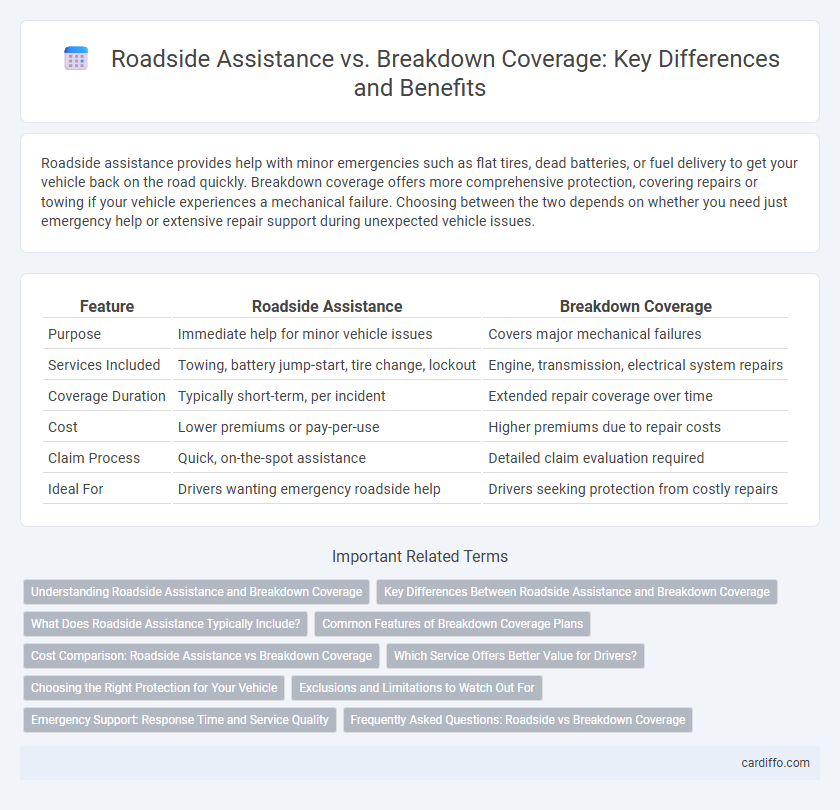Roadside assistance provides help with minor emergencies such as flat tires, dead batteries, or fuel delivery to get your vehicle back on the road quickly. Breakdown coverage offers more comprehensive protection, covering repairs or towing if your vehicle experiences a mechanical failure. Choosing between the two depends on whether you need just emergency help or extensive repair support during unexpected vehicle issues.
Table of Comparison
| Feature | Roadside Assistance | Breakdown Coverage |
|---|---|---|
| Purpose | Immediate help for minor vehicle issues | Covers major mechanical failures |
| Services Included | Towing, battery jump-start, tire change, lockout | Engine, transmission, electrical system repairs |
| Coverage Duration | Typically short-term, per incident | Extended repair coverage over time |
| Cost | Lower premiums or pay-per-use | Higher premiums due to repair costs |
| Claim Process | Quick, on-the-spot assistance | Detailed claim evaluation required |
| Ideal For | Drivers wanting emergency roadside help | Drivers seeking protection from costly repairs |
Understanding Roadside Assistance and Breakdown Coverage
Roadside assistance provides immediate help during vehicle emergencies such as flat tires, dead batteries, or lockouts, offering convenience and safety on the road. Breakdown coverage typically covers more extensive mechanical failures that leave a vehicle inoperable, including towing services and emergency repairs. Understanding the scope and limitations of each service helps drivers choose the right protection based on their travel habits and vehicle condition.
Key Differences Between Roadside Assistance and Breakdown Coverage
Roadside assistance primarily covers emergency services such as towing, jump-starts, tire changes, and lockout assistance, while breakdown coverage extends protection to mechanical failures and repairs due to vehicle defects. Roadside assistance is typically used for unexpected roadside emergencies, whereas breakdown coverage addresses issues related to the internal functioning and major parts of the vehicle. Understanding these distinctions helps drivers choose the appropriate level of protection for both emergency situations and vehicle maintenance needs.
What Does Roadside Assistance Typically Include?
Roadside assistance typically includes services like towing, battery jump-starts, flat tire changes, fuel delivery, and lockout help to get drivers back on the road quickly. It often covers emergency mechanical repairs directly at the roadside, minimizing the need for immediate towing. These services provide immediate support during vehicle breakdowns, ensuring safety and convenience without the higher cost of full breakdown coverage.
Common Features of Breakdown Coverage Plans
Breakdown coverage plans typically include services such as towing, battery jump-starts, fuel delivery, and flat tire changes to help motorists during vehicle malfunctions. These plans often cover mechanical failures and offer roadside assistance that extends beyond simple emergencies, ensuring vehicles are safely transported to repair shops. Many providers also offer benefits like locksmith services and trip interruption reimbursement, enhancing overall driver support.
Cost Comparison: Roadside Assistance vs Breakdown Coverage
Roadside assistance typically costs between $50 and $150 annually, offering services like towing, battery jump-starts, and flat tire changes, while breakdown coverage averages $200 to $600 per year with more comprehensive protection including major mechanical repairs. Roadside assistance plans often come as add-ons to auto insurance or through membership clubs like AAA, making them more affordable but limited in scope. Breakdown coverage, sometimes called extended warranty or mechanical breakdown insurance, provides broader repair coverage, justifying the higher cost for drivers seeking comprehensive financial protection against vehicle failures.
Which Service Offers Better Value for Drivers?
Roadside assistance provides immediate help for minor issues like flat tires, dead batteries, or lockouts, making it a cost-effective option for drivers seeking quick, on-the-spot support. Breakdown coverage covers extensive repairs and towing for major vehicle failures, often resulting in higher expenses but broader protection against costly repairs. Drivers prioritizing budget-friendly, frequent minor assistance may find roadside assistance offers better value, whereas those needing comprehensive repair coverage benefit more from breakdown coverage.
Choosing the Right Protection for Your Vehicle
Roadside assistance offers immediate help for minor emergencies such as flat tires, dead batteries, or lockouts, providing peace of mind during unexpected vehicle troubles. Breakdown coverage, on the other hand, covers costly repairs when major mechanical or electrical failures occur, protecting against expensive vehicle repairs. Choosing the right protection depends on your driving habits, vehicle age, and budget, ensuring you have tailored coverage that meets your specific roadside and repair needs.
Exclusions and Limitations to Watch Out For
Roadside assistance typically excludes coverage for mechanical breakdowns that require extensive repairs or parts replacement, focusing instead on immediate emergency services like towing, flat tire changes, and jump-starts. Breakdown coverage often excludes damage caused by improper maintenance, pre-existing conditions, or certain components like batteries and tires. Both require careful review of policy terms to avoid surprises such as mileage limits, service caps, or exclusions for specific vehicle types or situations.
Emergency Support: Response Time and Service Quality
Roadside assistance offers immediate emergency support with rapid response times typically within 30 minutes, providing on-site repairs or towing to ensure driver safety and convenience. Breakdown coverage focuses on extended protection, often resulting in slightly longer wait times but includes comprehensive repairs and towing services beyond immediate emergencies. Service quality in roadside assistance prioritizes quick resolution and minimal disruption, while breakdown coverage emphasizes thorough repair solutions for a wide range of vehicle issues.
Frequently Asked Questions: Roadside vs Breakdown Coverage
Roadside assistance typically covers immediate help such as towing, tire changes, and jump-starts during a vehicle breakdown, while breakdown coverage often includes comprehensive repair or replacement services. Consumers frequently ask if roadside assistance is sufficient alone or if breakdown coverage adds essential protection for major mechanical failures. Understanding the differences in coverage scope, response time, and repair benefits helps vehicle owners choose the best plan tailored to their driving habits and budget.
roadside assistance vs breakdown coverage Infographic

 cardiffo.com
cardiffo.com